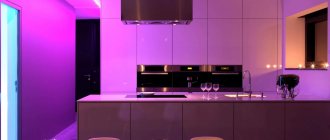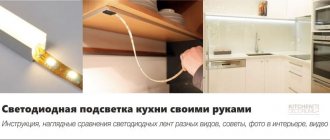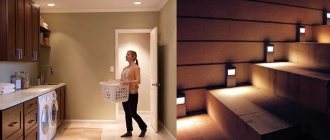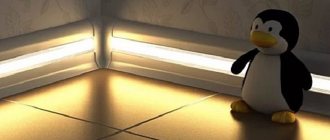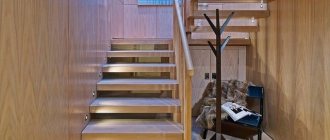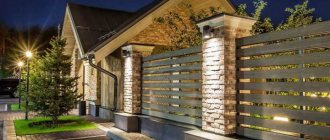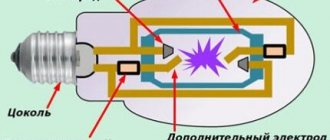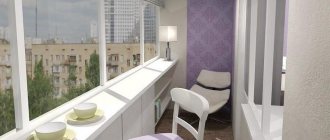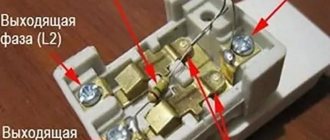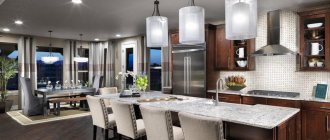The advent of LED strips has allowed modern designers to bring to life their most daring solutions. One of them is to make the work area in the kitchen fully comply with the regulatory requirements of SanPiN for lighting, and at the same time economical and beautiful. LED strips are precisely those elements that combine three important operational advantages at once.
LED strip for the kitchen under the cabinets
Advantages of LED lighting
New lighting devices have retained all the advantages of traditional technologies and collected modern scientific achievements.
- Mechanical strength and durability. The service life of such devices exceeds ten years, while the original technical parameters do not deteriorate. Lighting strips are mounted in durable metal cases, which completely eliminates mechanical damage.
- Various colors. LED backlighting is most often white, but if desired, consumers can install all the colors of the rainbow. The luminous flux can be stable or variable according to an electronic program.
- Safety. Lighting devices operate on 12 V or 24 V, such voltage does not pose a danger to users.
LED lighting for the kitchen work area
What do we need for installation?
Self-installation of LED backlighting will require the use of the following tools and components:
- The actual kit: tape reel (12W), electrical cable with a cross section of 0.74 mm square;
- Transformer - 12W power supply and dimmer with remote control (if available);
- Solder with rosin;
- Soldering iron;
- Scissors;
- Double sided tape;
- Insulating tape (or heat shrink tube with a heat gun);
- PVC corner and or aluminum profile for LED mounting – if necessary;
- Drill - if necessary;
- Electrical installation brackets - if necessary.
Types of desk lamps
Manufacturers offer various solutions for desk lamps. There are different types of housings, materials for their manufacture, luminous flux power, etc.
| Lighting type | Brief operational and technical characteristics |
| They are sold fully assembled and ready for installation or in separate parts. The second option requires professional knowledge of electrical installation, but makes it possible to create the most optimal options for each specific case. Finished equipment is installed within a few hours, but in many cases it is impossible to make adjustments to them. LED lamps are used as lighting devices. |
| They allow you to separately zone small spaces and focus attention only on those areas that are necessary for performing kitchen work. Each device operates separately and can be switched on either manually or automatically. Housings of various sizes and geometries can be metal or plastic. |
| The cabinets are hidden in kitchen furniture or walls above the work area. The most difficult installation option; installation requires special tools. Disadvantages: recessed lamps take a long time to install; they are not suitable for all sets of kitchen furniture. And this applies not only to design, but also to technical difficulties. |
When choosing a specific option, it is necessary to take into account the maximum number of individual factors, including the architectural features of the kitchen, the type of furniture and the cost of the system.
Prices for LED strips
LED strips
Selection of cable cross-section
Table for calculating cable cross-section
It is better to connect the lighting device with copper wire. Its cross section depends on the backlight power. An acceptable option is 0.75 mm2. To obtain accurate data, there is a formula: S=(2xIxpxL)/ΔU, where
- S – cable section;
- I – current strength, calculated by dividing power by voltage;
- L – wire length;
- p – metal resistance, taken from the reference book;
- ΔU – permissible voltage drop.
Calculations can be made using online calculators on various Internet resources.
Step-by-step instructions for connection
As an example, we will look at one of the many options for installing an LED strip. If you understand the principle and sequence of actions, then any other types of lighting will not be a problem.
Illumination of the work area in the kitchen
For installation, an LED strip with a power of 9 W/m is used. linear
Tape and power supply
The power of the power supply is selected depending on the length of the tape. To protect against mechanical damage and contamination, the tape is inserted into a special corner profile, which has a matte screen for uniform dispersion of the LED light flux along its length and a wire for power supply.
Profile with diffuser and wire
The tools you should prepare are an electric drill or screwdriver, a grinder with a metal disc, a soldering iron with all accessories, a degreaser, wire cutters, a screwdriver, a mounting knife, self-tapping screws and measuring tools.
Tools
Prices for popular models of screwdrivers
Screwdrivers
Step 1
. Remove the plastic light diffuser from the profile and drill holes for hardware on one side.
Drilling holes for hardware
The diameter depends on the fastener, the distance is approximately 40–50 cm. We specifically chose the option of fixing the profile to hardware; it is very reliable, although it requires more effort.
The profile will be fastened with hardware
Professional electricians categorically do not recommend mounting it with liquid glue; there is a high probability that over time, due to the influence of high humidity, the structure will come off with all the unpleasant consequences.
Step 2
. Screw the profile to the bottom of the wall-mounted kitchen furniture.
Fixing a profile
Practical advice. A little longer, but much more effective, before screwing it into the bottoms, drill holes of a slightly smaller diameter than self-tapping screws.
The fact is that the vast majority of furniture is made from laminated chipboard, and these boards crumble when screws are screwed in; you cannot install a self-tapping screw twice in the same place. If it becomes necessary to correct minor errors, problems will arise. It is much easier, after drilling holes in the profile, to place it in place, transfer the pitch of the holes to the furniture, and then make holes along them.
Step 3
. Prepare the profile for a corner connection, if such a need is caused by the design features of the furniture above the desk.
How it's done?
- Accurately measure the length of the required profile. Be sure to take into account the size of the plug, otherwise it will protrude slightly beyond the plane of the cabinets.
- Carefully trim the element. When cutting, do not overheat the metal and do not allow the decorative coating to burn.
- Prepare a hole of the appropriate diameter at the location where the power cable is connected.
Profile measurements and markings
Profile cutting
Drilling a hole for the wire and attaching a section of profile to the cabinet
Continue installing all remaining profiles using the same algorithm.
Step 4
. Solder the LED strip to the power cable, be sure to pay attention to the polarity.
Soldering the tape
There are special marks on the tape, and the wires have different insulation colors. Standards regulate the color of only two wires: ground (green with yellow streaks) and neutral (blue). Phase wires can have different colors, they are established by industry regulations.
How to solder LED strip
Wires are soldered to the tape
The current supply wire must be hidden behind the back walls of kitchen wall cabinets.
Step 5
. Glue the tape to the inner surface of the profile.
Important. Despite the fact that the profile seems clean and does not require preliminary preparation before gluing, it must be degreased.
Profile degreasing
The fact is that the technology for producing rolled products in bending machines uses technical lubricant. If it is not there, then microcracks and roughness will form on the metal surface. The lubricant layer is very thin, invisible to the eye, but it has a negative effect on adhesive compositions - adhesion indicators decrease by an order of magnitude. There is a risk that the tape will peel off and fall onto the diffuser; in some places its glow will become much brighter than the average length. This position does not have a negative impact on the performance characteristics of the lighting, but the appearance suffers.
Step 6
. Glue the tape to the profile.
Gluing tape
Remove the protective tape step by step and press the lamps tightly. The excess length must be cut off. Keep in mind that you only need to cut according to the marks. If it's a little longer, that's okay, bend the excess.
Step 7
. Reinstall the diffuser and install the plugs.
Diffuser installation
The plug is on
Step 8
. Connect the power supply. It can have different sizes and appearance; such factors do not influence the installation process. The power supply is connected in several stages.
- Remove the front housing cover. Behind it are terminals indicating the polarity of connecting the LED strip power wire.
- According to the polarity, firmly connect the wires to the terminals.
- On the other side of the power supply there are three terminals: ground, neutral and phase. Screw the power cable wires to them.
- Install the device in an unused space of the kitchen furniture. Most often it is placed next to the hood fan.
power unit
Turn on the backlight, if everything is normal, then you can safely use the device.
Using lighting in the kitchen work area
LED lighting is used not only in the kitchen. For example, tapes are used to create the effect of a floating stretch ceiling. You can make such a design from different materials, and which ones you can read on our website.
Video - Installation and connection of LED strip
Lighting for glass splashbacks
Illuminated glass aprons look incredibly impressive. Then the lighting fixture is not visible. It seems that the wall itself is glowing. Quite often they use glass with landscapes of the city and nature. Then you get the impression that there is a large panoramic window under the cabinet.
Halogen lighting fixtures are often used for this purpose. However, experts say: these lamps are not suitable because they create glare on a glossy surface. Most often, fluorescent lamps that provide uniform light and LED lamps are installed.
In addition to the traditional method of placement under the cabinet, lamps are also placed behind the panel . This not only makes the picture unusually realistic, especially in the dark. This lighting design is also practical: all the wires can be hidden behind the glass.
There are two more conveniences in such lighting:
- lighting fixtures are protected from moisture, soot and dust do not settle on them;
- Tempered glass, which is mainly used for finishing the work area, does not burn or melt.
Step-by-step instructions for making a skinali with backlight
The luminous apron is installed after the repair has been completely completed and the pencil cases have been installed. Before installing the system, measurements are taken. If there are old sockets or other objects on the wall, they are dismantled. Apply insulating tape to exposed wires.
Installation of the panel is carried out in the following sequence:
1. Make a canvas with LED strips, which is attached directly to the wall. It consists of foil (foil, paper base, polyethylene). An LED strip is glued on top of the foil in a horizontal direction, leaving a step of 5-10 cm between the rows. The wider the step, the dimmer the emitted light will be.
2. Attach the backlit foil to the wall. To do this, use an adhesive that is suitable for this surface. Where the sockets should be, holes are made through which the wiring is routed.
Foil with tapes is attached to the wall with glue or using double-sided tape
3. Install a frame made of wooden slats. The wood is pre-treated with antifungal and insecticidal drugs. Where the lath comes into contact with the wall, sealant is applied. Particular attention is paid to the area next to the sink.
4. Route the wiring of the backlight itself to the side where the control units will be located.
5. Install skins. If the working area is L-shaped, first install the corner profile. Then the lower holders are secured.
6. Insert the glass panel and, holding it at an angle of 45°, put the top profile on top of it. Secure the slats.
Systems for fastening skinnels with seals
Classification and comparison of LED strips
Appearance of SMD LED strips
LED strips are available in monochrome and multicolor versions. Products of the first type have LEDs of the same color.
The second row models consist of crystals of three or four colors:
- RGB - red, green, blue;
- RGB+W - red, green, blue, white.
Each row of diodes is connected to a separate channel. There are from 30 to 240 light bulbs per linear meter. Using dimmers of various designs, you can set the operating parameters of the device in overflow, pulsation or even lighting modes.
Classification of degrees of protection
According to the degree of protection against moisture, products are divided into the following categories:
- Open. Conducting lines are on the surface. When water gets on them, a short circuit occurs. Can be used for finishing objects located at a sufficient distance from the stove, window and sink.
- One-sided. The conductors are covered with silicone on top. The products are splash-proof and can be installed almost anywhere.
- Double sided. The strip is packed in plastic. You can attach and connect even inside sinks and hoods.
When choosing a tape, you should pay attention not only to tightness, but also to filling. It is advisable to illuminate the tabletop in white. For LED lighting for the kitchen under cabinets, it is better to choose RGB and RGB+W models.
Light in a small kitchen
It is the luminous flux, adjusted to the smallest detail, that can become the lifesaver that will save your tiny kitchen from despondency and forever make it friends with harmony and comfort.
You can always display a powerful chandelier with one large shade. It will provide decent illumination in the center - this is a plus. At the same time, the corners can be darkened - and this is a serious disadvantage. Point light sources or track systems will help correct the balance. They should be used for zone lighting: the work area, the sink, the set as a whole.
110 best small kitchen design ideas + a complete design guide can be found here.
Often, if there is a lack of usable space, it is possible to build general lighting solely on the basis of spots. Select them at the rate of 1 piece. by 1.5 sq. meters. But how to arrange it gives you complete freedom for your design inspiration.
Designer tips
Irina Polyakova
founder of the interior studio, architect and interior designer. The main area of work is kitchen design
There is an unspoken rule - to outline the contours of the kitchen set installed in the kitchen with spots. Most often in small kitchens they are either straight or angular, so a symmetrical linear construction will be required.
When developing a kitchen design project, give preference to light colors when decorating walls and selecting furniture. Still, they reflect light better, and this will greatly facilitate your task of creating a cozy atmosphere in the room.
Lamps should not hang very low from the ceiling. This visually reduces the height of an already small room. And too bright light in the immediate vicinity of the head blinds the eyes and does not add comfort.
Which lamps to choose for the kitchen
We reflected all the available options in the form of a table, where the advantages and disadvantages of each are described in detail.
| Types of lamps | Ratio of power to luminous flux (W - Lm) | Advantages | Flaws |
| Incandescent lamps | 100 — 1200 | cheap | overheat and quickly fail; consume a lot of energy; dim. |
| Luminescent | 30 — 1200 | moderately economical; produce decent brightness; | are more expensive; react to fluctuations in electricity in the network. |
| Halogen | 100 — 1300 | give very beautiful light; increased light output; make up for the lack of sunlight in the room | warming themselves; the spectrum shifts towards cool shades. |
| LED | 15 — 1200 | consume 10 times less electricity; may have different color temperatures; serve for a long time and do not go out during power surges; easily integrated into dimmer systems | expensive |
| Energy saving | 10/12 — 1200 | allow you to save on electricity; long service life. | contains mercury vapor |
